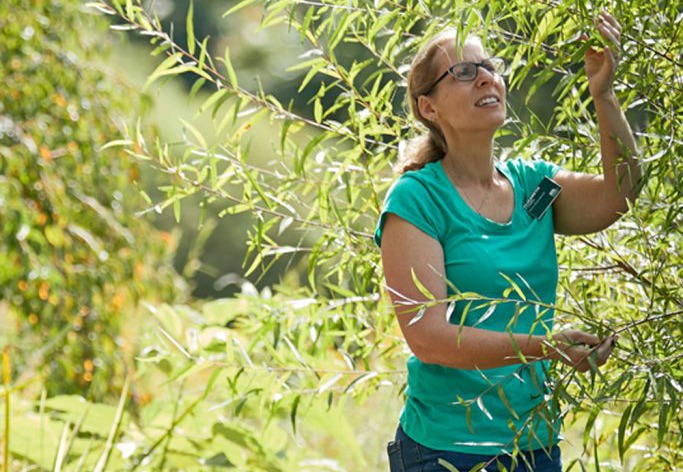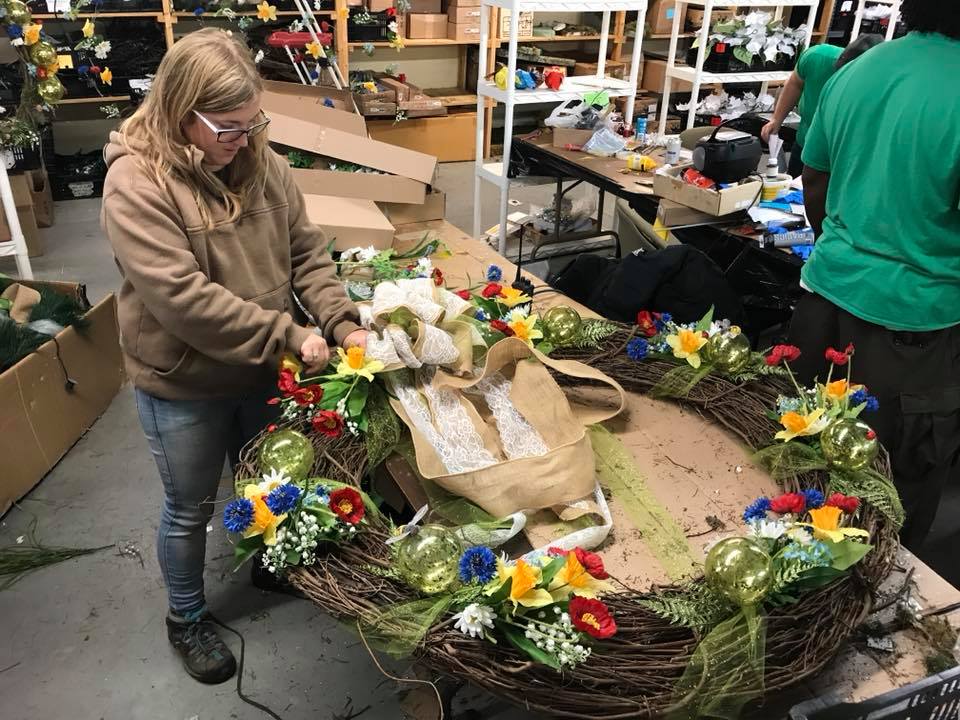FLOURISH
CELEBRATING OUR GARDEN AND ITS BEAUTY
June – October, 2024
2024 marks the Garden’s 40th Anniversary and to celebrate our horticulturists have created new, dazzling displays throughout the Garden. This year’s summer plantings will become lush as the season progresses through fall, with surprises and vignettes to discover in four iconic areas.
2024 marca el 40 aniversario del Jardín y para celebrarlo nuestros horticultores han creado nuevas y deslumbrantes exposiciones por todo el Jardín. Las plantaciones de verano de este año se volverán exuberantes a medida que avance la estación hasta el otoño, con sorpresas y viñetas por descubrir en cuatro zonas emblemáticas.
FOUR DISPLAYS DAZZLING ICONIC GARDEN AREAS
See display locations on the Garden Map
VICTORIAN SPLENDOR
Location: Grace Arents Garden
The Victorian Era was a time of great plant exploration and collection. During the 19th century, British imperialism and exotic plant hunting reached a peak. Thanks to new technology in glass manufacturing and coal-fired boilers, large, heated glasshouses grew in popularity and collecting rare specimen plants from around the world became a status symbol with Victorian elites. Plants that we now consider garden staples such as camellias became popular in gardens across the West due to Victorian plant enthusiasm. This era of plant exploration not only shaped the landscapes of Victorian gardens but also laid the foundation for modern botanical conservation efforts and the global exchange of plant species. However, there are a lot of lessons learned from these activities; not all good!
informacion en español
ESPLENDOR VICTORIANO:
REDESCUBRIENDO LOS ENCANTOS BOTÁNICOS DE UNA ÉPOCA
DISEÑADO POR ELIZABETH FOGEL
La Era Victoriana fue una época de gran exploración y recolección de plantas. Durante el siglo XIX, el imperialismo británico y la caza de plantas exóticas alcanzaron su apogeo. Gracias a las nuevas tecnologías de fabricación de vidrio y a las calderas de carbón, los grandes invernaderos con calefacción se hicieron muy populares y coleccionar especímenes raros de plantas de todo el mundo se convirtió en un símbolo de estatus para las élites victorianas. Plantas que hoy consideramos básicas en jardinería, como las camelias, se hicieron populares en los jardines de todo Occidente gracias al entusiasmo victoriano por las plantas. Esta era de exploración vegetal no sólo dio forma a los paisajes de los jardines victorianos, sino que también sentó las bases de los esfuerzos modernos de conservación botánica y del intercambio mundial de especies vegetales. Sin embargo, hay muchas lecciones aprendidas de estas actividades; ¡no todas buenas!
En nuestro esfuerzo por ser mejores administradores del mundo natural, te invitamos a leer algunas de estas lecciones en esta exposición.
Plant Information
Meet the Horticulturist

ELIZABETH FOGEL
ASSOCIATE DIRECTOR OF HORTICULTURE
Elizabeth Fogel has a long career in public gardens and natural resource conservation, including Longwood Gardens, US National Arboretum, and the US Peace Corps. She loves designing for both aesthetics and ecological values. Through working at a botanical garden, she appreciates the opportunity to educate the public about plants and their important role in sustaining all life.
Lessons Learned from the Victorian Era: The Good and the Bad
The Victorians learned how to collect, store, transport, and propagate plants over large distances and long durations. They increased agricultural crop diversity across the world leading to better food security, and inspired innovation in all aspects of life including arts and culture.
However, we now know that the practice of harvesting plants from wild areas is unsustainable and leads to the introduction of invasive species. Old practices also lead to appropriation and monetization of plants of cultural importance. Modern conservation practices strive to empower communities where plants occur to thrive in perpetuity, if not partner to relocate or conserve plants in other locations with institutions like botanical gardens.
SHADED SERENITY
Location: Flagler Perennial Garden
Shade plants are often overlooked in garden design but are important for the lushness and tranquility they bring to spaces. They offer environmental benefits too, from helping prevent soil erosion to cooling and conserving water. Shade gardens also contribute to biodiversity by supporting various wildlife. By incorporating these resilient and versatile plants into our outdoor spaces, we can cultivate beautiful, sustainable landscapes that nourish the soul and support the health of the planet.
informacion en español
SERENIDAD SOMBREADA:
UN DESPLIEGUE DE VERDE
DISEÑADO POR MEGAN LACEY
Las plantas de sombra suelen pasarse por alto en el diseño de jardines, pero son importantes por la exuberancia y tranquilidad que aportan a los espacios. Además, aportan beneficios medioambientales, desde la prevención de la erosión del suelo hasta la refrigeración y conservación del agua. Los jardines de sombra también contribuyen a la biodiversidad al favorecer la vida silvestre. Al incorporar estas plantas resistentes y versátiles a nuestros espacios exteriores, podemos cultivar paisajes bellos y sostenibles que nutren el alma y favorecen la salud del planeta.
Hay mucha creatividad y magia en un jardín de sombra. Esperamos que nuestra exposición te inspire y te convenza para que no tales los árboles de tu jardín.
Plant Information
Begonia boliviensis 'Fimissmo' I'conia® Miss Montreal | begonia
Carex appalachica | Appalachian sedge
Dichondra argentea ‘Silver Falls’ | dichondra
Euphorbia hypericifolia ‘Balbrewite’ Breathless® White | spurge
Heuchera villosa ‘Bronze Wave’ | hairy alum root
Muehlenbeckia axillaris | creeping wire vine
Nephrolepis obliterata | Australian swordfern
Meet the Horticulturist

Megan Lacey
Horticulture Section Leader
De-Mystifying Shade by Megan Lacey
While we all know how great it feels to be underneath the shade of a tree on a hot summer day, I often notice frustration from gardeners who struggle to figure out what to plant in a shady area. Many times, I’ve heard gardeners say, “I have shade so I can’t grow anything.” This arch marks the entrance to an area where gardeners can come to feel inspired on what to plant in their own shady spaces.
The plants on the arch were picked for their ability to thrive in shade and tolerate drought. The Boston ferns (Nephrolepsis obliterata) and sedge (Carex appalachica) and the climbing rambling habit of the wire vine (muhlenbeckia) work together to create a woodland feel. The tuberous begonias (Begonia x tuberosa ‘Miss Montreal’) offer larger more eye-catching flowers, and the grassleaf spurge (Euphorbia hypericifolia ‘Breathless White’) acts as a stunning filler with its delicate white flowers.
Partial Shade is defined as 3 to 6 hours of sun. Often these areas receive sun before noon when it is less intense. Some of our favorite perennials that perform well in partial shade locations include Geranium macrorrhizum (cranesbill), Tricyrtis formosana (toad lily), Anemone x hybrida (windflower), and Astilbe. Some of our favorite annuals for partial shade include Begonia x tuberosa (tuberous begonia) and Torenia fournieri (wish-bone flower).
Dappled Shade also referred to as Filtered Sun is defined as sunlight that filters through the canopy of open tree branches. Plants in these areas can receive a significant amount of light but it is unpredictable and highly seasonal since light patterns are constantly shifting. Some of our favorite perennials for dappled shade include Epimedium sp. (bishops hat), Polemonium sp. (Jacob’s ladder), Trillium sp. (wake robin) and Symphyotrichum cordifolium (blue wood aster). Some of our favorite annuals for dappled shade include Impatiens walleriana (busy Lizzy) and Fuschia x hybrida (lady's eardrops).
Deep Shade also referred to as Full Shade is often found under evergreens and other dense trees and shrubs. In a deep shade location, direct sunlight rarely occurs. Some of our favorite perennials for deep shade include Hosta sp. (hosta), Helleborus x hybridus (hellebore) and Athyrium niponicum var. Pictum (japanese painted fern). Some of our favorite annuals for deep shade include Solanostemon sp. (coleus) and Caladium x hortulanum (caladium).
TROPICAL TREASURES
Location: Central Garden
Tropical plants, with their vibrant colors and lush foliage, bring a touch of paradise to any landscape. Beyond their beauty, they are resilient champions against climate change, thriving in warm, humid climates. Their unique adaptations make them well-suited to withstand shifting environmental conditions. In a changing world, they offer hope by creating sustainable landscapes that can endure. Whether adorning a botanical garden, enhancing indoor spaces, or gracing outdoor landscapes, tropical plants not only dazzle the eye but also serve as resilient ambassadors of nature’s adaptability in the face of environmental change.
informacion en español
TESOROS TROPICALES:
EXPLORANDO LA FLORA EXÓTICA DE TIERRAS LEJANAS
DISEÑADO POR DANNY COX, DEAN DIETRICH, JAYTON HOWARD Y CLARE REINES
Las plantas tropicales, con sus vibrantes colores y exuberante follaje, aportan un toque paradisíaco a cualquier paisaje. Más allá de su belleza, son campeonas resistentes al cambio climático y prosperan en climas cálidos y húmedos. Sus adaptaciones únicas las hacen idóneas para soportar condiciones ambientales cambiantes. En un mundo cambiante, ofrecen esperanza al crear paisajes sostenibles que pueden perdurar. Ya sea adornando un jardín botánico, realzando espacios interiores o adornando paisajes exteriores, las plantas tropicales no sólo deslumbran a la vista, sino que también sirven como embajadoras resistentes de la adaptabilidad de la naturaleza frente al cambio medioambiental.
Aprender sobre el cambio climático y la adaptación es esencial en estos tiempos. Esta exposición, así como otras partes de la programación de nuestro Jardín, pretende educar a nuestra comunidad para crear un mundo mejor para las generaciones futuras.
Plant Information
Chaenostoma cordatum ‘Baverlu’ Versa™ Blue | bacopa
Cuphea hyssopifolia Cupid™ Purple | false heather
Echeveria cv. | echeveria
Neoregelia ‘Chili Verde’ | bromeliad
Neoregelia ‘Fireball’ | bromeliad
Neoregelia ‘Super Fireball’ | bromeliad
Strobilanthes alternata ‘Exotica’ | purple waffle plant
Brugmansia ‘Jamaica Yellow’ | warm group angel’s trumpet
Chaenostoma cordatum ‘Baverlu’ Versa™ Blue | bacopa
Codiaeum variegatum var. variegatum ‘Banana’ | croton
Cuphea hyssopifolia Cupid™ Purple | false heather
Echeveria cv. | echeveria
Euphorbia tirucalli | Indian tree spurge
Isolepis cernua | fiber optic grass
Mandevilla cv. | white mandevilla
Muehlenbeckia axillaris | creeping wire vine
Tradescantia pallida ‘Purpurea’ | spider lily
+ assorted bromeliad varieties
Meet the Horticulturists

DANNY COX
VICE PRESIDENT, HORTICULTURE
A leader in public horticulture for more than a decade, Danny Cox oversees the Horticulture Department, setting the vision for the curation, growth, and maintenance of botanical collections. He combines lifelong passions for plants and people by creating innovative landscape displays that inspire and delight visitors and celebrate Lewis Ginter Botanical Garden’s diverse membership.

DEAN DIETRICH
Ex-Horticulture Section Leader
“People ask me where I get my ideas. I follow designers around the globe and read their books, Instagram and blog posts. Their designs inspire me. Unique plants do, too. We’re furthering our botanical collections here at the Garden. We collect them because they’re interesting [and] saving germplasm can also help save a species.”
Dean has accepted a position at Longwood Gardens overseeing a part of their new conservatory.

Jayton Howard
Conservatory Horticulturist
Jayton Howard grew up in Oregon working at his mother’s flower shop, had the privilege of studying horticulture in Australia where he also managed a garden shop for 5 years, then moved to Hawaii to specialize in tropical growing where he managed wholesale nursery operations as well as a cacao and coffee farm. Now he is here in Richmond at Lewis Ginter Botanical Garden as the Conservatory Horticulturist where he gets to keep the tropical lifestyle alive.
Clare Reines
Assistant Horticulturist
Clare grew up with an innate fascination with plants and nature. She pursued her degree in horticulture at Virginia Tech while working on a mountainside flower farm, igniting her love for flowers and floral design. During the pandemic, she transferred to Oregon State University to finish her studies remotely while living in Brooklyn, New York, concurrently obtaining her Certificate in Horticulture from Brooklyn Botanic Garden. She became a lead floral designer in Brooklyn and hosted events throughout the city for companies such as Puma, Kate Spade, and Rémy Martin; doing so while running her own houseplant business out of her apartment. After moving to Richmond in 2023, she became an Assistant Horticulturist at Lewis Ginter Botanical Garden where she gets to combine her love for horticulture and design.
Aquatic Plants by Danny Cox
Of the several hundred thousand species of plants in the world only a small percentage are specialized for life in the water. Despite the relatively small species number in comparison to all terrestrial plants, aquatic plants are incredibly diverse with very specialized structures and growth habits that allow them to thrive in their wet environments.
Examples of this diversity include the iconic flowers waterlilies (Nymphaea spp.), the enormous pads of giant water platters (Victoria spp.) watermeal (Woflia spp.) one of the smallest flowering plants in the world, and rice (Oryza spp.), one of the largest cereal crops in the world. Regardless of their shape or size, aquatic plants provide food and habitat for many vertebrates and invertebrates, help to stabilize lake and stream edges, and are a critical component to healthy water quality as they help filter out excessive nutrients in water.
Among the aquatic plants in the Garden’s aquatic plant collections are waterlilies (Nymphaea spp.) and lotus (Nelumboo spp.) which can be seen here. Can you tell the difference between the waterlilies and lotus in this pool?
Bromeliads by Jayton Howard
What do pineapples, Spanish moss, and air plants all have in common? That’s right, they’re all bromeliads! Bromeliads come from the family Bromeliaceae which contains over 3,000 described species and 56 genera. They are diverse plants with lots of differing growth habits. As long as you have bromeliads in the right conditions, they’re generally very easy to grow and care for. Just watch out for the spikey foliage or tips that some bromeliads grow as modified foliage. These spikes help keep the plant from becoming a snack as well as getting covered in jungle floor vines.
While there is one species of Bromeliad found native to Western Africa, ALL the rest are from the Neotropics or New World Tropics and subtropics. They grow in a range of conditions from sea level to up to 14,000 feet above sea level! Bromeliads are adaptable and have found a way to grow in most tropical or subtropical conditions. You can find bromeliads growing as terrestrial ground dwelling plants, as climbing epiphytic plants growing above the ground in trees, or saxicolous growing on rocks and rocky surfaces. There are even some bromeliads that are pushing their boundaries and are more cold hardy than the rest: certain varieties are capable of surviving temperatures down to 20F or –6C!
Container Plants by Jayton Howard
There are a lot of reasons to grow plants in containers, and not just because it looks nice. It gives us more control over growing conditions and often makes things easier for gardeners, by simply being able to place the container in the most ideal conditions for plants to thrive.
Growing plants in pots also allows us to bring them indoors and have a touch of nature in our homes. This can be good for our stress levels and indoor air quality, too. Gardeners can also think beyond traditional pots: terrariums, hanging baskets, and plants climbing on grow poles are all great ways to facilitate growing indoors.
Outdoor container gardening doesn’t have to be limited to pots, either. Raised garden beds, hanging baskets, window boxes, over rail planters, and growing walls all count as container gardening. Containers also give us a chance for seasonal color, herbs and veggies, and perennial display pots without having to dig down into hard clay soil. Containers help us adapt as gardeners to a variety of growing conditions and make much of today's modern food practices possible.
NATURAL CONNECTION
Location: Sensory Garden
Plants are the unsung heroes of our everyday lives, silently working to improve our well-being in countless ways. From the air we breathe to the food we eat, plants play a crucial role in sustaining human life on Earth. Plants give us food, and are also used to make medicine, as well as everyday items like clothing. They are part of traditions and rituals of cultures around the world, they heal us and create an intergenerational connection.
In addition to their physical benefits, plants have a profound impact on our mental and emotional well-being. The sight and scent of plants evoke feelings of calmness and relaxation, providing a natural antidote to the pressures of modern life. In essence, plants are not just passive inhabitants of our world; they are active contributors to our health, happiness, and overall quality of life.
informacion en español
CONEXIÓN NATURAL:
CELEBRANDO EL PAPEL DE LAS PLANTAS EN NUESTRA VIDA COTIDIANA
DISEÑADO POR ELIZABETH FOGEL
Las plantas son los héroes anónimos de nuestra vida cotidiana, ya que trabajan silenciosamente para mejorar nuestro bienestar de innumerables maneras. Desde el aire que respiramos hasta los alimentos que comemos, las plantas desempeñan un papel crucial en el sustento de la vida humana en la Tierra. Las plantas nos dan de comer, y también se utilizan para fabricar medicinas, así como artículos cotidianos como la ropa. Forman parte de tradiciones y rituales de culturas de todo el mundo, nos curan y crean una conexión intergeneracional.
Además de sus beneficios físicos, las plantas tienen un profundo impacto en nuestro bienestar mental y emocional. La vista y el olor de las plantas evocan sentimientos de calma y relajación, proporcionando un antídoto natural contra las presiones de la vida moderna. En esencia, las plantas no son meros habitantes pasivos de nuestro mundo; contribuyen activamente a nuestra salud, felicidad y calidad de vida en general.
Tómate tu tiempo para interactuar con la naturaleza y crear un vínculo más estrecho con ella. Te invitamos a probar más, aprender más, utilizar más materiales naturales e integrar más plantas en tu vida cotidiana.
Plant Information
Meet the Horticulturist

ELIZABETH FOGEL
ASSOCIATE DIRECTOR OF HORTICULTURE
Elizabeth Fogel has a long career in public gardens and natural resource conservation, including Longwood Gardens, US National Arboretum, and the US Peace Corps. She loves designing for both aesthetics and ecological values. Through working at a botanical garden, she appreciates the opportunity to educate the public about plants and their important role in sustaining all life.
Great Gourds
Gourds are one of the earliest domesticated plants. They are an extremely diverse family of fruits - pumpkins, melons, squash, cucumbers are all classified botanically as berries. They have been used extensively throughout history as instruments, storage containers, eating utensils, birdhouses, and even as a form of currency in Haiti!
The Luffa gourd (Luffa sp.) is perhaps the most unusual of all with vines that can climb up to 50 feet, large fuzzy star shaped leaves, and long hanging fruits. Being native to Asia, they thrive in hot weather and acidic soil. The fruits should be harvested while still green and can be eaten raw or cooked. The term “loofah” as we know it today originates from the dried fruits being used as natural sponges.
Okra by Lauren Hwang-Finkelman
Okra (Abelmoschus esculentus) is an annual vegetable crop native to tropical Asia and Africa. It is beloved from Creole to Indian cuisines for its edible seed pods, called capsules, that form after flowering. Okra is easily grown from seed, which can be sown directly into the ground after all danger of frost has passed. It is a fast-growing plant that thrives in our hot and humid Virginia summers. People with sensitive skin should wear gloves when harvesting the capsules – some okra can have tiny, fuzzy spines that cause skin irritation. Try growing the variety ‘Clemson Spineless’ or other non-fuzzy selections next summer for smooth, delicious, okra pods. And don’t forget to pickle some of the harvest for a crispy treat to enjoy after the growing season ends!
Cotton by Lauren Hwang-Finkelman
Cotton (Gossypium hirsutum) is an agricultural crop grown for its white, fluffy fiber. The fiber is produced within the fruiting pod, called a capsule, that bursts open when it is ready to harvest. To process cotton, the fluffy fiber must be separated from the seeds that are imbedded within it. The processing of cotton is very time and labor intensive. Roughly 27 million tons of cotton is grown around the world each year. The majority of this annual production is used for clothing and home furnishings. During the early to mid-nineteenth century, the United States became the world’s largest producer of cotton by using enslaved African American labor to grow and harvest the plant throughout the Southeast.
Roselle by Lauren Hwang-Finkelman
Roselle (Hibiscus sabdariffa) is an edible plant in the mallow family and is related to okra and cotton. Hibiscus tea is made from this plant’s calyx, the set of modified leaves that surround and protect flower buds before they bloom. Roselle calyces are bright red, floral and sour in flavor. They are used to make richly pigmented tea, wine, jam, juice, and jelly. All parts of the plant are edible, including the leaves, flowers, and roots. Roselle originated in Central and West Africa and is widely used in cuisines throughout the Caribbean, Asia, and Central America. Grown year round in hotter climates, this tropical plant is very sensitive to cold temperatures and does not survive our winters.
Marigolds by Eryn Boyle
Native to Mexico & Guatemala, marigold (Tagetes) is believed to have protective qualities to ward off evil spirits, misfortune, and negative energy. They are used in rituals, celebrations, and folk medicine. They are also associated with good fortune, happiness, and protection. Mexican marigolds play a central role in Dia de los Muertos (Day of the Dead) as adornments to ofrendas in homes and cemeteries. Their bright color is believed to help guide spirits back into the human world for the holiday. In addition to cultural uses, marigolds make great companion plants, especially in vegetable gardens, as they repel pests, grow quickly, attract pollinators, and are low maintenance.
Flourish: 40th Anniversary Celebration Classes, Tours & Lectures
This year marks four decades of Lewis Ginter Botanical Garden, and we’re celebrating for the whole year with favorite events as well as exciting new ones. Through our 40th Anniversary theme, “Flourish,” our goal is to honor the work that has come before, celebrate where we are now, and look forward to the transformational changes kicking off in 2024. Our anniversary programming includes special classes, tours, and a Speaker Series highlighting the Garden’s past, present, and future.
Membership Includes Unlimited Flourish Visits
Become a member and you can enjoy all of the Flourish excitement and events for one low price.
